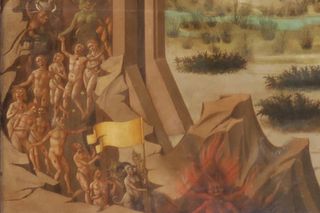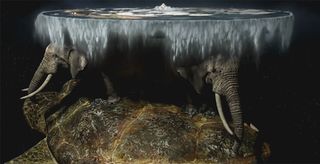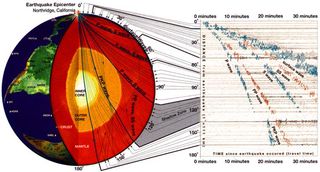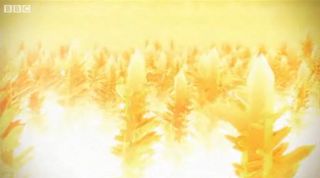Religion and Science: 6 Visions of Earth's Core
Intro

One can imagine a day when humans will venture freely to our neighboring planets, and use powerful telescopes to learn about nearby stars. Someday, we will surely explore every inch of the ocean's depths , as well as all the most impenetrable forests. But we'll probably never journey to the center of the Earth. The hardiest drills penetrate only 7 miles (12 km) deep that's just 0.2 percent of Earth's radius before encountering such high heat that they melt. In all likelihood, the extreme temperature and pressure of our planet's interior place it permanently out of reach.
Perhaps partly for this reason, the inside of the Earth has always fascinated us. It plays a central role in many traditional religions and cosmologies. More recently, science has begun to probe it indirectly, gradually bettering our understanding of its nature. Here is a chronological look at humanity's ever-evolving understanding of the fiery world beneath our feet.
Pit of hell

Perhaps the most widespread traditional view of the center of the Earth portrays it as a lake of fire where bad people spend eternity: Yes, hell. Connections to the afterlife aside, the picture of the underworld as, essentially, a fiery pit is somewhat accurate. And perhaps it isn't so surprising that so many religions and cosmologies got it right: Volcanic eruptions occasionally provided ancient cultures with horrific glimpses of the hellfire below.
In fact, brimstone as in "fire and brimstone," a frequent metaphor for hell found in the Christian Bible is a type of rock commonly found on the rims of volcanoes.
World turtle

Many East Asian and Native American cultures did not picture the Earth's interior as a hellish place. Instead, they imagined a giant turtle. Called "the world turtle," it supported the Earth usually conceived of as flat , or dome-shaped, rather than spherical on its back. There are several variations to the myth: Hindus replaced the turtle with an elephant, while some historians, perhaps conflating the two descriptions, have described a cosmology where the world rests on the back of an elephant that stands on a turtle.
Why a turtle? As the anthropologist Frank Speck pointed out in a 1931 treatise on the world turtle myth of the Delaware Indians, not only is the creature's back an appropriately curved shape, but the Delaware believed that turtles embody the traits of perseverance, longevity and steadfastness. What's more, they thought that time and turtles alike continuously moved from east to west.
So what's below the turtle? Most myths do not specify. In "A Brief History of Time" (Bantam Dell 1988), the physicist Stephen Hawking recounts a well-known anecdote in which a supporter of the world turtle cosmology is confronted with the question. She answers that the turtle stands on the back of another turtle, which stands on another, and that there are "turtles all the way down."
Core of gold

Bernard Wood, a geologist now at the University of Oxford in the U.K., calculated that there are 1.6 quadrillion tons of gold in the Earth's core, or enough to coat the planet's surface in a 1.5-foot layer. He thinks there is also six times that amount of platinum another precious metal as well as nickel, niobium and other "iron-loving" elements down there. Wood formed this hypothesis after analyzing the metal content of meteorites that are similar to "planetesimals" small bodies that crashed together to form Earth at the dawn of the solar system. He found that these meteorites have much more gold, platinum and the other stuff distributed throughout them than does the surface of the Earth, and deduced that the iron in the Earth's core must have drawn these elements inward during the planet's formation.
The picture above exaggerates: Though 1.6 quadrillion tons is a huge quantity by Earth's-surface-standards, gold atoms still make up just one millionth of the total number of atoms in the core. Meteorites, as well as the mass and density of Earth (deduced from how it perturbs the orbits of the moon and other planets), lead scientists to believe that the vast bulk of the core is iron and nickel.
[Why Did Gold Become the Best Element for Money? ]
Onion layers

The rumblings of the Earth's crust whisper the secrets of what lies beneath. When there's an earthquake, the seismic waves it emits ricochet through the Earth, redirecting and reflecting off boundaries between the crust, mantle, outer core and inner core, and then get recorded on seismograms all over the world. Scientists retrace the waves' steps to map out the Earth's interior.
So what's the lay of the land down there? In the very center, there's a solid ball of iron and nickel. Though Earth's center is believed to have a temperature of approximately 5,500 degrees Celsius (9,900 degrees Fahrenheit) about as hot as the surface of the Sun it also has an extremely high pressure , more than 3 million times that of the atmosphere at the planet's surface. This pressure drives up the melting temperature of metals, so that they are solid despite the inner core's high heat.
At about 760 miles (1,216 km) out from the center, the pressure dips low enough to allow the iron and nickel to melt. According to David Stevenson, a geologist at Caltech and a leading expert on the Earth's core, this outer liquid layer makes up about 95 percent of the core's total volume.
The mantle begins about 2,200 miles (3,500 km) out from the center. This molten rock composes the thickest layer of the Earth, and constitutes about 84 percent of the planet's total volume. The mantle is coated by a thin crust our home.
Crystal ball

Evidence suggests that the inner core is no homogeneous chunk. Scientists have noticed that seismic waves pass through the core faster when traveling from one pole to the other than they do traveling crosswise, from one point on the equator to the opposite point. This means the inner core is "anisotropic" structured differently in one direction than another. Most experts believe this must be because it is composed of anisotropic crystals that are aligned with the Earth's magnetic poles .
Geophysicist Ronald Cohen of the Carnegie Institute in Washington has found that the time difference between waves penetrated the inner core horizontally and vertically match what would be expected if the iron and nickel atoms in the core were arranged in a mix of two types of crystals. Some iron-nickel crystals are likely arranged in a hexagonal close-packed (hcp) structure, and some in a face-centered cubic structure. In short, there are two types of crystals in the inner core; the atoms in each of them are stacked like the balls in the two pictures above.
According to Cohen, the crystals probably but up against each other in the very center of the core, where the pressure is highest, "like in a rock." Farther out, "there may be some liquid between them."
Forbidden forest

Kei Hirose, a Japanese geologist, recently conducted an experiment in which he replicated the conditions at the center of the Earth on an extremely small scale in the lab. Using a diamond-tipped vise, a clamp-like tool, he heated up a piece of iron-nickel alloy to 4,500 degrees-C and 3 million times atmospheric pressure. Based on what happened to the sample under these core-like conditions, he deduced that the crystals in the center of the Earth may each measure 6 miles (10 km) tall, and point between the poles. (On the atomic scale, the atoms in each crystal are still stacked as described in the previous slide. Only on a much larger scale do the crystals appear jagged and pointy.) Hirose describes the core as a "crystal forest."
[Amazing Video: Planet Made of Diamonds ]
Sign up for the Live Science daily newsletter now
Get the world’s most fascinating discoveries delivered straight to your inbox.
Natalie Wolchover was a staff writer for Live Science from 2010 to 2012 and is currently a senior physics writer and editor for Quanta Magazine. She holds a bachelor's degree in physics from Tufts University and has studied physics at the University of California, Berkeley. Along with the staff of Quanta, Wolchover won the 2022 Pulitzer Prize for explanatory writing for her work on the building of the James Webb Space Telescope. Her work has also appeared in the The Best American Science and Nature Writing and The Best Writing on Mathematics, Nature, The New Yorker and Popular Science. She was the 2016 winner of the Evert Clark/Seth Payne Award, an annual prize for young science journalists, as well as the winner of the 2017 Science Communication Award for the American Institute of Physics.

